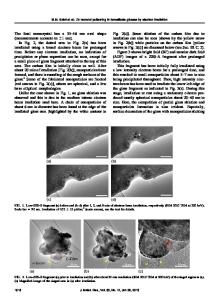Development and Characterization of Borosilicate Glasses for Immobilization of Plutonium-containing Alkaline Sludges
- PDF / 5,897,225 Bytes
- 10 Pages / 612 x 792 pts (letter) Page_size
- 76 Downloads / 296 Views
Development and Characterization of Borosilicate Glasses for Immobilization of Plutonium-containing Alkaline Sludges A.S. Aloy1, O.A. Iskhakova1, T.I. Koltsova1, A.V. Trofimenko1 and L.J. Jardine2 RPA (V.G. Khlopin Radium Institute), St. Petersburg, Russian Federation 2 University of California, Lawrence Livermore National Laboratory, USA 1
ABSTRACT Several glasses were melted using laboratory-scale microwave (MW) equipment to study the vitrification of Pu-containing sludges from the Mining and Chemical Combine in Zheleznogorsk, Russia. This work is part of an effort to identify glass compositions that can be adopted for industrial scale production. The glass must meet durability requirements and have good technological properties for long-term storage and geologic disposal. Electron Probe Analysis (EMPA), scanning electron microscope (SEM) and x-ray methods were used to characterize glasses containing 50 wt% solid sludge residues with high sodium content. Leach tests of 3, 7, 14, and 28 day durations were performed using the MCC-1 method at 90°C. The surface of the glass was analyzed before and after leaching. Based on the observed results, there are differences in the behavior of Pu and U for the glasses tested, and glass durability is dependent on homogeneity, the uranium oxidizing state, and the SiO2/Na2O+Li2O ratio. INTRODUCTION It has been shown [1] that immobilization of the Pu-bearing sludges into glass-like matrixes instead of cementation matrixes increases the waste storage safety by fixing plutonium reliably in a strong and stable material. It also provides increased physical protection and nuclear safety of solidified waste during long-term storage and makes possible the final disposal of solidified waste into geological formations. Preliminary estimates show that keeping solidified Pu-bearing materials in deep geologic disposal sites is safe. This type of disposal also excludes nonauthorized access to these Pu-containing wastes, and resolves some issues associated with nonproliferation of fissile materials. A principal objective of this work is the optimization of the glass composition for vitrification of Pu-containing sludges. The sludges to be immobilized were generated at Mining and Chemical Combine (MCC), Zheleznogorsk (Siberia), where weapons-grade plutonium was produced during long-term operation of that radiochemical plant. The main factor in the optimization process is that the glasses must meet durability requirements while remaining processible using remotely operated and maintained equipment in hot cells. The initial work was done using a microwave (MW) vitrification process for sludges containing sodium at no more than 15 g/L [2]. The results were used to perform a technical and engineering feasibility study of the vitrification of Pu-bearing sludges at MCC by means of MW heating [1].
MW energy was selected because it could react with many types of solid residues of variable composition, heating only the material to be treated. In addition, most of the MW operating equipment can be locat
Data Loading...











